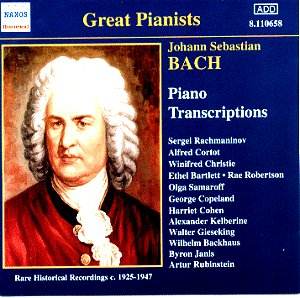The raison d’être for the disc is to select twelve
pianists from amongst the very many who recorded Bach Transcriptions
on the piano in the 78 era. We thus range in terms of recording date
from a British pianist much esteemed by collectors of 78s, Winifred
Christie, and her Moór Duplex-Coupler piano circa 1925 to the
young Byron Janis in 1947. Additionally twelve different transcribers
are included (sometimes the performer – such as Rachmaninov, Cortot
and Harriet Cohen - is also transcriber). It will be noted that some
of these recordings are making their first appearance on CD as well.
All this has been so attractively done that it seems churlish to wonder
whether there is a ready audience for so disparate a collection. Still,
that thought aside – and the thought that a number of these transcription
recordings were themselves "fill-ups" for longer works – there
is still a great deal to enjoy here; mainly this will centre around
those pianists generally now unfamiliar.
I don’t know how Winifred Christie (1882-1965) would
have reacted to being called Ms Winifred Christie by sleeve note writers
Marina and Victor Ledin – probably with bafflement. I’d hope with suave
belligerence. She championed the Bechstein Duplex-Coupler Piano (a two-manual
affair an octave apart. The "coupler" device overcame spread
chords), which was invented by composer Emanuel Moór, because
she married him in 1923 – a fact the notes don’t tell us. She was also
a composer and recorded selectively for Aeolian Vocalion and Winner,
premiered Edgar Bainton’s Concerto-Fantasia and was one of Britain’s
leading pianists. I hope this splendid recording of the Moór
adapted Bach-Tausig Toccata and Fugue will revive her memory. Bostonian
George Copeland (1882-1971) plays a transcription by another elite pianist,
Walter Rummel, whose Bach playing I admire enormously. Copland, like
Christie, moved in Harold Bauer’s orbit but additionally studied with
the legendary Teresa Carreño. He was a Debussy proselytizer,
giving many American premieres but became overshadowed by other lesser
pianists and never recorded as widely as his talents merited. His Jesus
Christus, Gottes Sohn is moving and magnificent. Harriet Cohen was
a Matthay student; her early Columbia part complete recording of the
Well Tempered Clavier was shared with the older pianist Evlyn Howard
Jones, friend of Delius, whose portion was significantly more impressive
than hers. She plays her own transcription of the Chorale from Cantata
no 22 with straightforward intelligence. I’m afraid I found Alexander
Kelberine rather strait-laced; the tragically short-lived Russian (1903-40)
studied with two giants, Busoni and Siloti, and also with the peripatetic
Leo Sirota. He committed suicide after suffering a long period of acute
depression. The Myra Hess transcription is given to Walter Gieseking,
inferior to Lipatti’s recording of it, but full of clarity if not exactly
dripping with sentiment. Janis’ youthful boldness – he was nineteen
– is if anything topped by Rubinstein’s incandescence and leonine drama
in the Toccata in C major in the Busoni transcription. All however are
smitten by the greatest pianist here, Rachmaninov, who opens proceedings
with three movements from the third Violin Partita in his own memorable
transcription. Not much time to mention Cortot’s affectingly beautiful
Aria – noisy copy though, I’m sure a better one could have been found
– and the globe trotting Bartlett and Robertson in the Mary Howe transcription
of Sheep May Safely Graze, to use the familiar Anglicism.
Olga Samaroff (1882-1948) is not afraid to dig into her Fugue transcription
– impressive – and Backhaus is dependable in the Pastorale from the
Christmas Oratorio.
I particularly commend this disc for its retrieval
function or in Stevie Smith’s words "the lost dawn recover."
This is not a back-handed compliment, I hope, but is on the contrary
meant to draw attention to those pianists upon whom I have concentrated
in this review. Their sensitivity and depth fully deserve to live once
again in such glorious company.
Jonathan Woolf


